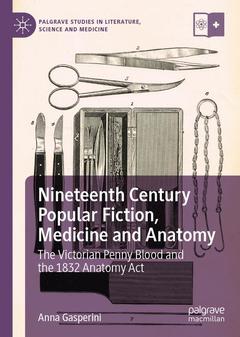Description
Nineteenth Century Popular Fiction, Medicine and Anatomy, 1st ed. 2019
The Victorian Penny Blood and the 1832 Anatomy Act
Palgrave Studies in Literature, Science and Medicine Series
Author: Gasperini Anna
Language: English
Subjects for Nineteenth Century Popular Fiction, Medicine and Anatomy:
Support: Print on demand
Description
/li>Contents
/li>Biography
/li>Comment
/li>
This book investigates the relationship between the fascinating and misunderstood penny blood, early Victorian popular fiction for the working class, and Victorian anatomy. In 1832, the controversial Anatomy Act sanctioned the use of the body of the pauper for teaching dissection to medical students, deeply affecting the Victorian poor. The ensuing decade, such famous penny bloods as Manuscripts from the Diary of a Physician, Varney the Vampyre, Sweeney Todd, and The Mysteries of London addressed issues of medical ethics, social power, and bodily agency. Challenging traditional views of penny bloods as a lowlier, un-readable genre, this book rereads these four narratives in the light of the 1832 Anatomy Act, putting them in dialogue with different popular artistic forms and literary genres, as well as with the spaces of death and dissection in Victorian London, exploring their role as channels for circulating discourses about anatomy and ethics among the Victorian poor.
Anna Gasperini received her PhD from the National University of Ireland Galway. She specialises in Victorian popular fiction, Victorian medical history, and spatial and discourse theory. She is the current Membership Secretary of the UK-based Victorian Popular Fiction Association (VPFA).




